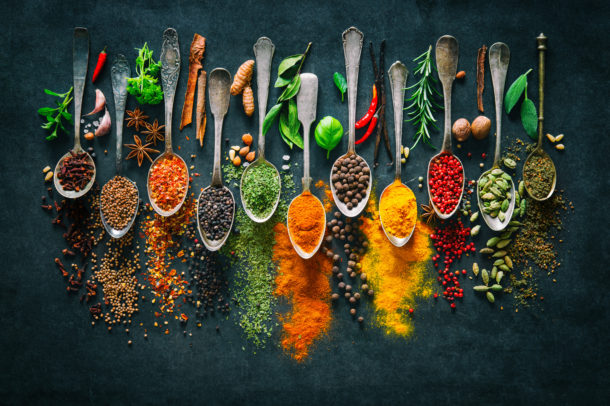Sodium (commonly known as salt or sodium chloride) is important for regulating blood pressure, nerve and muscle function, and acid-base balance of blood and body fluids. Too much sodium can be harmful for those with kidney disease, as it’s more difficult for kidneys to get rid of excess sodium, fluids and wastes in the body. This can result in higher blood pressure, which can further reduce kidney function. Therefore, it is recommended for those with kidney disease to limit their sodium intake.This can oftentimes be difficult as sodium is commonly used to flavour food.
The good news is that there are many different ways to flavour our food using simple ingredients you already have at home.
Keep reading for tips to make your food taste great without having to add more salt!
- Fresh produce can improve the flavour in many different foods. Try using shredded carrots, crunchy bell peppers, or fresh spinach as side dishes to your homemade meals. Freshly squeezed lemon/lime juice can be used to flavour sauces, marinades, and salad dressings. Onions, green onions, garlic, and ginger are common flavourful bases that can be added to stir-frys, marinades, soups, and sauces.
- Herbs and spices, whether fresh or dried, can add a great deal of flavour to foods, especially to cooked vegetables. Try using freshly chopped basil, cilantro, chives, dill, oregano, parsley, rosemary, sage, and thyme as a topping on cooked vegetables and or a pasta dish.
You can also combine a batch of your favourite dried herbs to make your own spice mixes. Some great flavour combinations include dried coriander, ginger, garlic, and sesame seeds, or chili flakes, paprika, and oregano. - Flavourful oils can be used to drizzle on top of a meal or used in salad dressings and marinades. Some good examples include sesame oil, which is commonly used in Asian cuisine, and olive oil, which is used in a variety of cuisines.
- Vinegars can boost flavour in sauces and act as a good base in salad dressings. Apple cider vinegar, wine vinegar, balsamic vinegar, and rice vinegar are common examples.
- Salt-free seasoning mixes can be convenient if pressed for time or for those that are unsure on how to make seasoning blends. Common brands include Mrs. Dash©, President’s Choice©, and Clubhouse©. When using salt-free mixes, it’s important to check the ingredients to ensure “potassium chloride” is not listed, as those with kidney disease should limit potassium.
If you are interested in making your own spice mixes but unsure where to start, try some of these spice mixes below!
Salt-Free Seasoning Blends
| All-Purpose Salt Substitute 1 Tbsp mustard powder 1 Tbsp garlic powder 1 Tbsp onion powder 1 Tbsp paprika 1 ½ teaspoon black pepper 1 tsp basil 1 tsp thyme | Italian Blend 2 Tbsp basil 2 Tbsp marjoram 1 Tbsp garlic powder 1 Tbsp oregano 2 tsp thyme 2 tsp rosemary, crushed 2 tsp crushed red pepper Best for pastas, soups, chicken, pizza and bread | Asian Blend 2 Tbsp sesame seeds 2 Tbsp onion powder 2 Tbsp ground anise 2 Tbsp ground ginger 1 tsp ground allspice ½ tsp cardamom ½ ground cloves Best for vegetables, poultry, and fish |
| Mexican Blend 5 Tbsp chili powder 2 tsp garlic powder 1 tsp onion powder 2 tsp paprika 3 Tbsp cumin 2 tsp black pepper 1 tsp cayenne pepper Best for tacos, fajitas, enchiladas, and chili | Mediterranean Blend 2 Tbsp dried oregano 2 Tbsp thyme 2 tsp crushed rosemary 2 tsp basil 1 tsp marjoram 1 tsp dried parsley Best for poultry and seafood | Curry Blend 2 Tbsp turmeric 2 Tbsp ground coriander 1 Tbsp ground cumin 2 Tbsp ground cardamom 2 tsp ground ginger 2 tsp black pepper 1 tsp ground cloves 1 tsp cinnamon 1 tsp ground nutmeg Best for vegetables, lentils, chickpeas, and chicken |
It’s important to monitor your sodium intake to keep your kidneys healthy, which can be hard because it is added to many food items to improve flavour. Luckily, there are many options that you can use to make foods flavourful without the added sodium! If you have more questions on how to limit your sodium intake, speak to your registered dietitian.
See our Fact Sheet for more information about Sodium
Written by Jennifer Snyder, 5th year dietetics student at the University of British Columbia, and reviewed by Dani Renouf, RD, MSc
References
Davita. (2020). Sodium and Chronic Kidney Disease. Retrieved on June 3, 2020 from https://www.davita.com/diet-nutrition/articles/basics/sodium-and-chronic-kidney-disease
Providence Health Care. (2017). Seasoning Without Salt. Retrieved June 4, 2020
National Kidney Foundation. (n.d.). Sodium and Your CKD Diet: How to Spice Up Your Cooking. Retrieved June 3, 2020 from https://www.kidney.org/atoz/content/sodiumckd
BC Renal Registered Dietitian’s Group. (2016). Kidney-Friendly Shopping List. BC Renal Agency. Retrieved June 3, 2020 from https://www.bcrenalagency.ca/resource-gallery/Documents/Kidney%20Friendly%20Shopping%20Guide%20Final.pdf
Byrd, M. (2018). 7 No Salt Seasoning Blends. The Oregon Dietitian. Retrieved June 4, 2020 from https://theoregondietitian.com/2018/08/15/7-homemade-salt-free-seasoning-recipes/
